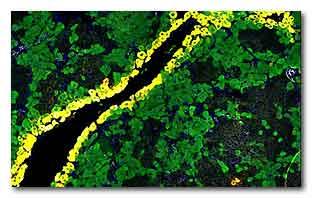|
A new study has revealed that bile duct cells can
switch to become normal liver cells to help repair
the liver after severe damage.

A regenerating liver vein (orange) with bile duct
cells (white) and hepatocytes (green). Image credit:
Alex Raven, MRC Centre for Regenerative Medicine.
Understanding how this back-up system is controlled
could pave the way for new liver therapies, say the
scientists from the Medical Research Council (MRC)
Centre for Regenerative Medicine at the University
of Edinburgh.
The study, published today in Natureopens in new
window, investigated hepatocytes, which are the main
cell type found in the liver.
Hepatocytes play a key role in cleaning toxic
substances from the blood stream.
After minor damage, hepatocytes can multiply to
repair the damage, but if the injury is too severe
the cells cannot cope and they stop proliferating.
This can lead to chronic liver disease.
The researchers developed a system to mimic chronic
liver disease in mice.
They discovered that, after severe liver injury,
another type of cell in the liver, called
cholangiocytes, were reprogrammed to become
functional hepatocytes.
The cholangiocytes are specialised cells that line
bile ducts in the liver.
These cells normally regulate the secretion of bile,
a fluid that helps break down fats from food.
The researchers say their findings pave the way to
develop drugs that encourage bile duct cells to
become hepatocytes to help repair liver tissue.
Lead researcher Professor Stuart Forbes, Director of
the MRC Centre for Regenerative Medicine at the
University of Edinburgh, said: “This is the first
conclusive proof that bile duct cells can serve as
an important back-up system to help repair damaged
liver tissue. We think this back-up system is
helping the liver to repair, but under severe strain
it might not be enough.
“So we plan to test drugs, that are already
clinically approved for other conditions, on human
bile duct cells to see if they can increase their
regenerative capacity.
We’re hopeful that understanding the signals that
trigger these cells to behave this way could lead to
new therapies to help repair damage before the
livers fail completely.”
Liver disease is the one of the top five causes of
premature death in the UK.
Chronic liver disease can have many causes,
including viruses such as hepatitis, toxicity from
drugs such as paracetamol, and non-alcoholic fatty
liver disease.
For more information
Nature
Cholangiocytes act as facultative liver stem cells
during impaired hepatocyte regeneration
Link...
MRC Centre for Regenerative Medicine
University of Edinburgh
Link...
MDN |